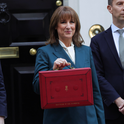Milk, woke. Tractors, cool. Immigrants, bad.
These are my concluding fieldnotes, collected during a venture into territory no Prospect staff member has dared to go: the Reformosphere.
Back in February I (re)downloaded an app I had gladly deleted from my phone long ago: TikTok. Here, Reform receives nearly 14 times as much engagement per post as the main parties. On TikTok, The Nige has more followers than every other MP combined. But why?
To find out, I’m willing to brave a mind-numbing vortex of 10-second videos and endless (endless!) catchy tunes on loop. In the name of journalism, of course, and not merely to spend time on TikTok while at my desk.
Reform UK. Following.
Nigel Farage. Following.
Labour next, then the Tories (though, is there any point seeing what the Tories are up to anymore?). A quick peek at the other parties. My guess is the other 400,000 or so Reform followers aren’t all intrepid reporters—or Russian bots—and I want to discover what keeps them here, the laws that govern ReformTok.
The doomscroll begins.
A comment from SirPorkingtonPie catches my eye: “Reform are too soft. Sorry.”
1. Man up
As the Conservatives grapple with an ageing voter base (the average Tory is 63 years old), Reform’s gaze has turned to the “yutes”. And among young people, there’s a clear gender divide. Polling taken shortly after the last general election showed that young men were twice as likely to vote Reform than their female counterparts. They haven’t forgotten it.
On Reform’s account, one clip gets rinsed and repeated: Farage the fighter, walking onto the stage in slow motion, filmed from the back and lit by stage lights. The images are blue-tinted, the editing sleek. Pyrotechnics go off. The music is pumping, triumphant—he’s waving to the crowd. There’s the air of a UFC match—something Trump has also used in order to portray himself as an alpha male. I feel my testosterone levels soaring.
There’s an element of self-conscious showmanship. It’s not meant to be analysed.
Around the election last year, Karin-Wahl Jorgensen, professor of journalism, media and culture at Cardiff University, noted Farage’s “bewildering” variety of transportation around the election, travelling by car and by train. “But also: Helicopter! Armoured vehicle! Boat! Another boat! Oh, and a combine harvester!”
He’s trundling around Runcorn in a tractor! At a rally in Birmingham, he rolls on stage clinging to the side of a digger (more on that later).
All the stunts with heavy construction and agricultural machinery look like a bid to connect with workers and farmers. There’s a “boys and their toys” theme, Jorgensen tells me, but also a sense of constructing, of building things. She doesn’t think the transportation metaphors are entirely accidental: they show Reform is “about progress, being on the move, getting stuff done”.
But there’s an element of self-conscious showmanship. It’s not meant to be analysed. “It comes across as something that [Farage] thinks is fun and endearing.”
2. Be yourself (or at least look like it)
When Farage is on TikTok, he’s speaking to you.
While Labour attempts to make Starmer look cool or relatable from a distance, Farage the influencer has a direct, unmediated connection with the viewer. (He’s not the first British politician to do this—David Cameron tried it as leader of the opposition in 2006, doing domestic chores while vlogging on webcameron).
On TikTok, authenticity—or at least its appearance—is key.
When he’s not speaking to the camera, Farage is an ordinary man doing ordinary, manly things: he’s drinking beer! He’s in a boxing gym! A betting shop! A shooting range! More beer! A tattoo parlour–the camera pans to reveal a (temporary) bulldog tattoo. Or watching the footie at the pub with other blokes (cricket is a bigger part of his life than football, he once admitted, but there’s no cricket to be found on his TikTok. Wonder why).
On TikTok, authenticity—or at least its appearance—is key.
“We’re taking on the establishment”, he declares, in front of a digger donated by the billionaire and long-time Tory superdonor Anthony Bamford. He’s suited and booted, striding across the stage, lamenting the condition of the silent, ignored majority.
He’s cosplaying as a farmer; critiquing the milk options at a posh hotel (has the full-fat been conveniently moved out of the shot?); delivering his New Year’s message from Blenheim Palace (renting a room can cost around £40,000, but in the spirit of class solidarity, we can hope that any fee was waived by Farage’s reported pal, the 12th Duke of Marlborough).
But he doesn’t pretend to be a disaffected teenager. He doesn’t pretend to be part of “your generation, the TikTok generation”. At least on Farage’s own account, Jorgensen thinks he portrays himself as a “cool grandpa” who articulates the anxieties of the young.
Things are harder. Last summer, an open letter addressed to Farage asked for a “Reform Youth” wing. “These years have been immensely difficult for us, and have damaged our faith in politics and politicians”, the petitioners wrote. They were concerned about the cost of housing, interest rates on tuition fees and a sense of dwindling freedom and autonomy. Labour doesn't know how to tap into this frustration.
3. Aura is everything
Labour’s videos are a textbook example of youth appeal content: frenetic editing, gen Z lingo, memes galore. So why do they struggle to get the clicks? It’s not for lack of trying—the Labour account posts far more than any other party (296 videos in April alone, compared to just 80 on Reform’s party account). But Reform still got nearly eight times more engagement. It boils down to one word: “aura”. If you don’t know what that means in this context, chances are you’re in the wrong age bracket. (I also had to ask my younger gen Z compatriots, and was pityingly offered an explanation). One Reddit user helpfully defines it as “the hypothetical ‘badass energy’ you emit”.
A recent video on Labour’s TikTok shows the word “AURA” rapidly interspersed with photos of the PM. “This is what REAL aura looks like” the caption declares. They’ve tried impossibly hard to find photos of Starmer looking cool–a feat apparently so difficult that they had to reuse the same four images to fill 13 seconds.
In the battle between “cool grandpa” and centrist dad, you can guess who has the edge
We see Starmer in tight trousers, standing stiffly in front of an army plane, squinting into the sunlight. Starmer standing stiffly next to world leaders. Starmer sitting in a chair with a flag behind him. Various combinations of Starmer sitting and standing. You get the picture.
It’s a valiant effort, but in the comment section, which is filled with Reform supporters, the video has fallen flat. Labour TikTok has a skateboard swung over its shoulder, asking “how do you do, fellow kids?”
In the battle between “cool grandpa” and centrist dad, you can guess who has the edge. The prime minister wears the vaguely disappointed expression of a headmaster about to summon you into his office. And she’s just Rachel from accounts. Even half-decent lines sound sort of flat, not saved even by a backing track of mushy music and soft ocean sounds.
The only pro-Starmer comments I’ve found are from one bloke called Keith, whose feed is exclusively populated with pro-Starmer memes, and whose AI-edited profile picture suspiciously resembles the man himself. (I’m starting to suspect Keith might be a certain party leader's burner account).
ToryTok is barely worth a visit: an unhinged Robert Jenrick chases people around for skipping the TFL barrier, and raves about the government “bribing paedophiles” like a Poundland Farage. Minus 300 aura points.
4. Always punch down
It’s a fine February day in TikTokland when I first notice a shift in Labour’s online messaging. It’s aesthetically a different style of video, removed from their other peppy, text-cluttered clips. It almost feels like the video is visually imitating Reform’s style. It is simpler, stronger (though I notice the clip of a British flag waving in background—even Reform isn’t that on-the-nose).
After a string of videos attacking the government’s immigration policy, Labour has finally cracked and squeezed out a video declaring that, actually, the government has “removed the highest number of people with no right to be here since 2018” and “organised four of the biggest return flights in UK history”.
Labour’s on the back foot, defending territory that doesn’t belong to it.
A few days later, Reform responds with a searing rebuttal. Newspaper headlines snap onto the page: “Daily Mail: “Fury as more than 25,000 small boat migrants have reached Britain since Labour came to power”, one after the other in quick succession.
The numbers count up. Then it flashes: “Nearly. The. Size. Of. Great Yarmouth.”
“What have you done Keir?”
Labour’s on the back foot, defending territory that doesn’t belong to it.
5. Stick to the script
Three months later, Labour releases its new immigration white paper and Reform is gleefully still churning out TikToks.
Starmer is now an easy target—a video overlaid with audio of him saying things like “the whole of the UK is better because of immigration” is interspersed with images of fires, violence, a police car being attacked, asylum seekers in lifejackets.
During his leadership bid, Starmer even implied that Jeremy Corbyn had not been pro-immigration enough, accusing Labour of being “scared of making the positive case for immigration for quite a number of years”.
“Don’t believe a word they say” says Reform’s TikTok. They know it sounds like Starmer’s willing to say anything to scrape an inch higher in the polls. Farage, on the other hand, knows people have been laughing at him for years and has relentlessly banged on about immigration despite that.
He is loving this.
When the PM put an English flag outside Number 10 for St George’s day, Farage appeared gloating on Reform’s account: “They’re dancing to our tune”.
A clip of Farage at PMQs shows him responding to Starmer’s “island of strangers” spiel: “We at Reform… very much enjoyed your speech on Monday. You seem to be learning a very great deal from us!”
And he knows that, for his supporters, what Labour says will never be enough. One moment is especially telling: in an 11-second clip, Starmer is asked by the Daily Express whether “going further means disentangling ourselves from the ECHR and disapplying human rights law in immigration cases?” His “no” is a gotcha.
“Only Reform UK will leave the ECHR and deport all illegal migrants”, the caption says.
In another video: “Only Reform UK will stop the boats and protect our borders.”
Something that “really works well with social media”, says Jorgensen, is that Reform’s “message is quite simple… It's around how immigration is bad. Immigrants are bad. People who are not like us are bad.”
6. Trust the pipeline
Do you, like SirPorkington, still think Reform’s page is too soft? No fear, the algorithm will give you what you’re after.
My For You Page (FYP) rapidly descends into pushing an immigration raid on a kebab shop–superimposed with some animated Union Jacks.
Where the Reform TikTok uses dog-whistles, my For You Page hollers.
On GB News, a hotel owner is horrified that the government offered him a sum of money to house asylum seekers in limbo (“I don’t know whether they intended to contain them, or whether they would be allowed”—he spreads his hands out—“out and about”).
Where the Reform TikTok uses dog-whistles, my FYP hollers.
It gives me the sense of being swarmed. They’re everywhere. When I go home to visit my family, I find that a pack of foreigners has taken over the house! The young man who has situated himself across from my old bedroom doesn’t even bother to speak English. (Well, it could be English, but he’s grunting in monosyllables, so I can’t tell.)
I ask him if he’s come here illegally. He says “what do you mean? I’m your brother”. He’ll be on a plane to the Balkans by the end of the week.
By then, I will have reported myself to the British Transport Police (I looked suspicious), become a Daily Mail top commenter, and told my grandma to go back to where she came from.
When I speak to Jorgensen, she explains that social media is a “means of bypassing the kind of scrutiny that politicians conventionally get from traditional media organisations”. TikTok, and spaces like it, have allowed Reform an “unmediated, uninterrupted, unchallenged” platform to get its core messages across.
Unlike Labour, the Reform account doesn’t really post memes. There’s room for silliness on Farage’s personal page, but not the party TikTok. Instead, its output is high-quality, very polished, and not specifically targeted to young people. This is shrewd.
As TikTok’s platform grows, its demographic base widens. YouGov data last year showed that almost half of weekly US TikTok users were 35 and older (up from 33 per cent in 2022), and I wouldn’t be surprised if a similar trend is present in the UK. Keeping that broad appeal has helped turn Reform into a set of legitimate political actors and MPs, taken at face value by mainstream media.
There’s room for silliness on Farage’s personal page, but not the party TikTok
Labour doesn’t need to focus on production value on TikTok in the same way. The party knows the platform’s users aren’t its main voter base, and that followers don’t necessarily translate into votes. But Labour also operates on the understanding that only teenagers use TikTok, which isn’t necessarily true—and which is why some of their content can make your skin crawl.
When the time finally comes to delete that tiny musical note icon, I reflect that I have sacrificed my attention span, time and dignity—and wonder if I may have emerged slightly more right-wing. The word “uninstall” has never sounded so sweet. Good riddance to all that.












